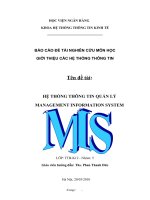Lecture Business management information system - Lecture 27: Supporting decision making
Bạn đang xem bản rút gọn của tài liệu. Xem và tải ngay bản đầy đủ của tài liệu tại đây (1.18 MB, 54 trang )
Supporting
Decision Making
Lecture 27
Systems for Supporting KnowledgeBased Work
n
Today we shall look at,
¨
¨
¨
¨
¨
n
n
Decision Support Systems (DSS)
Data Mining
Executive Information Systems (EIS), and
Expert Systems
Agent-based Modelling
How to create a real-time enterprise
Case examples include: a problem-solving scenario, OreIda Foods, a major services company, Harrah’s
Entertainment, Xerox Corporation, General Electric,
American Express, Delta Air Lines, a real-time interaction
on a website, and Western Digital
Introduction
n
Most computer systems support decision making
because all software programs involve automating
decision steps that people would take
n
Decision making is a process that involves a variety
of activities, most of which handle information
n
A wide variety of computer-based tools and
approaches can be used to confront the problem at
hand and work through its solution
A PROBLEM-SOLVING SCENARIO
Case Example – Supporting Decision Making
n
Using an executive information system, (EIS) to
compare budget to actual sales
n
Discover a sale shortfall in one region
n
Searches for the cause of the shortfall
n
But couldn’t find an answer
A PROBLEM-SOLVING SCENARIO
Case Example – Supporting Decision Making
cont.
Investigate – several possible causes
n
n
Economic Conditions – through the EIS & the Web
accesses:
¨ Wire services
¨ Bank economic newsletters
¨ Current business and economic publications
Competitive Analysis – through the same sources
investigates whether competitors:
A PROBLEM-SOLVING SCENARIO
Case Example – Supporting Decision
Making cont.
¨ Have
introduced a new product
¨ Have launched an effective ad campaign
n
n
Written Sales Report – browses the reports
¨ “Concept based” text retrieval system makes this
easier
A Data Mining Analysis
¨ Looking for any previously unknown relationships
A PROBLEM-SOLVING SCENARIO
Case Example – Supporting Decision Making
cont.
n
Then accesses a marketing DSS – includes a set of
models to analyze sales patterns by:
¨ Product
¨ Sales representative
¨ Major customer
Result – no clear problems revealed.
Action – hold a meeting, in an electronic meeting room
supported by group DSS (GDSS) software
A PROBLEM-SOLVING SCENARIO
Case Example – Supporting Decision
Making cont.
n
This scenario illustrates:
¨ The
wide variety of activities involved in problem
solving, and
¨ The
wide variety of technologies that can be used to
assist decision makers and problem solvers
Technologies that Support Decision Making
n
The purpose of tractors, engines, machines etc. = to
enhance humans’ physical capabilities
n
The purpose of computers has been to enhance our
mental capabilities
Hence, a major use of IT is to relieve humans of
some decision making or help us make more
informed decisions
n
Technologies that Support Decision Making
Decision Support Systems
n
n
n
n
Systems that support, not replace, managers in their
decision-making activities
Decision modeling, decision theory, and decision
analysis, attempt to make models from which the ‘best
decision’ can be derived, by computation
DSS are defined as: Computer-based systems
¨ That help decision makers
¨ Confront ill-structured problems
¨ Through direct interaction
¨ With data and analysis models
Wide range of technologies can be used to assist
decision makers and problem solvers
Decision Support Systems
The Architecture for DSSs
n
n
Figure 11-1 shows the relationship between the three
components of the DSS model
Software system in the middle of the figure consists
of:
¨ The database management system (DBMS)
¨ The model base management system (MBMS)
¨ The dialog generation and management system
(DGMS)
Decision Support Systems
The Architecture for DSSs cont.
The Dialog Component
n The DSS contains a dialog component to link the user
to the system
n Was ‘mouse’ (Mac) now = browser interface
The Data Component
n Data sources – as the importance of DSS has grown,
it has become increasingly critical for the DSS to use
all the important data sources within and outside the
organization
Decision Support Systems
The Architecture for DSSs cont.
Data warehousing
n Data mining
¨ Much of the work on the data component of DSS has
taken the form of activities in this area
The Model Component
n Models provide the analysis capabilities for a DSS
¨ Using a mathematical representation of the problem,
algorithmic processes are employed to generate
information to support decision making
n
Decision Support Systems
Types of DSS
n
n
The size and complexity of DSS range from large
complex systems that have many of the attributes of
major applications down to simple ad hoc analyses
that might be called end user computing tasks
Institutional DSSs tend to be fairly well defined
¨ They are based on pre=defined data sources
n Heavily internal with perhaps some external
data
Decision Support Systems
Types of DSS
Use well established models in a prescheduled way
Quick-hit DSSs are developed quickly to help a manager make
either a one-time decision or a recurring one
¨
Can be every bit as useful for a small or large company
¨
Most today = Excel spreadsheets (and not ‘called’ DSS)
¨
n
ORE-IDA FOODS
Case Example – Institutional DSS
n
n
n
n
Frozen food division of H.J. Heinz
Marketing DSS must support 3 main tasks in the
decision making process:
1.
Data retrieval – helps managers find answers to
the question, “what has happened?”
2.
Market analysis – addresses the question, “Why
did it happen?”
3.
Modeling – helps managers get answers to, “What
will happen if…?”
Modeling for projection purposes, offers the greatest
potential value of marketing management
For successful use – line managers must take over
the ownership of the models and be responsible for
keeping them up-to-date
A MAJOR SERVICES COMPANY
Case Example – “Quick Hit” DSS – Short Analysis
Programs
n
n
Considering – new employee benefit program: an
employee stock ownership plan (ESOP).
Wanted a study made to determine the possible impact
of the ESOP on the company and to answer such
questions as:
¨
¨
n
n
How many shares of company stock will be needed in 10,20
and 30yrs to support the ESOP?
What level of growth will be needed to meet these stock
requirements?
The information systems manager wrote a program to
perform the calculations & printed the results
Results = showed the impact of the ESOP over a 30yr
period
¨
Surprising results
Technologies that Support Decision Making
Data Mining
n
A promising use of data warehouses is to let the computer
uncover unknown correlations by searching for interesting
patterns, anomalies, or clusters of data that people are
unaware exist
Called data mining, its purpose is to give people new
insights into data
Also covered in Chapter 7
n
Most frequent type of data mined = customer data
n
n
HARRAH’S ENTERTAINMENT
Case Example – Data Mining (Customer)
n
n
n
To better know its customers, Harrah’s encourages
them to sign up for its frequent-gambler card, Total
Rewards
Harrah’s mined its Total Rewards database to
uncover patterns and clusters of customers
It has created 90 demographic clusters, each of
which is sent different direct mail offers –
encouraging them to visit other Harrah’s casinos
¨ Profit and loss for each customer calculating the
likely ‘return’ for every ‘investment’ it makes in that
customer
HARRAH’S ENTERTAINMENT
Case Example – Data Mining (Customer)
n Much of its $3.7B in revenues
cont. (and 80% of its profits)
n
n
comes from its slot machines and electronic gamingmachine players
¨ Found = locals who played often
It was not the ‘high rollers’ who were the most
profitable
Within the first two years of operation of Total
Rewards, revenue from customers who visited more
than one Harrah’s casino increased by $100 million
Technologies that Support Decision Making
Executive Information Systems (EIS)
n
As the name implies EISs are for use by executives
n
They have been used for the following purposes:
1.
Gauge company performance: sales, production,
earnings, budgets, and forecasts
Scan the environmental: for news on government
regulations, competition, financial and economics
developments, and scientific subjects
2.
Technologies that Support Decision Making
Executive Information Systems (EIS) cont.
n
EIS can be viewed as a DSS that:
1. Provides access to summary performance data
2. Uses graphics to display and visualize the data in an
easy-to-use fashion, and
3. Has a minimum of analysis for modeling beyond the
capability to “drill down” in summary data to examine
components
n
In many companies, the EIS is called a dashboard and
may look like a dashboard of a car
n
n
n
XEROX CORPORATION
Case Example – Executive Information
System
The EIS at Xerox began small and evolved to the point
where even skeptical users became avid supporters
Its objective was to improve communications and
planning, such as giving executives pre-meeting
documents
It was also used in strategic planning and resulted in
better plans, especially across divisions
Executive Information Systems (EIS)
Pitfalls in EIS Development
1.
Lack of executive support: executives must provide
the funding, but are the principal users and supply the
needed continuity
2.
Undefined system objectives: the technology, the
convenience, and the power of EIS are impressive,
but the underlying objectives and business values of
an EIS must be carefully thought through
3.
Poorly defined information requirements: EIS typically
need non - traditional information sources judgments, opinion, external text-based documents in addition to traditional financial and operating data









